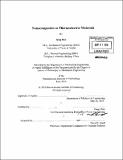Nanocomposites as thermoelectric materials
Author(s)
Hao, Qing
DownloadFull printable version (18.85Mb)
Other Contributors
Massachusetts Institute of Technology. Dept. of Mechanical Engineering.
Advisor
Gang Chen.
Terms of use
Metadata
Show full item recordAbstract
Thermoelectric materials have attractive applications in electric power generation and solid-state cooling. The performance of a thermoelectric device depends on the dimensionless figure of merit (ZT) of the material, defined as ZT = S2o-T / k, where S is the Seebeck coefficient, o is the electrical conductivity, k is the thermal conductivity, and T is the absolute temperature. In recent years, the idea of using nanotechnology to further improve the figure of merit of conventional thermoelectric materials has triggered active research and led to many exciting results. Most of the reported ZT enhancements are based on thin films and nanowires in which the thermal conductivity reduction plays a central role. We pursue the nanocomposite approach as an alternative to superlattices in the quest for high ZT materials. These nanocomposites are essentially nano-grained bulk materials that are synthesized by hot pressing nanoparticles into a bulk form. The interfaces inside a nanocomposite strongly scatter phonons but only slightly affect the charge carrier transport. Therefore, we can significantly reduce the lattice thermal conductivity and even somewhat increase the power factor S2 U, resulting in higher ZT than for bulk materials. Compared with expensive thin-film superlattices, nanocomposites will have significant advantages in mass production, device construction and operation. This thesis covers my studies on bismuth antimony telluride nanocomposites and some recent work on Co 4Sb12-based nanocomposites. In bismuth antimony telluride nanocomposites, we have achieved a peak ZT of 1.4 at 100 'C, a 40% increase in ZT over the bulk material. This is the first significant ZT increase in this material system in fifty years. The same approach has also yielded a peak ZT around 1.2 in Yb filled Co4Sbi 2 nanocomposites. During the process, great efforts were dedicated to assuring accurate and dependable property measurements of thermoelectric nanocomposites. In addition to comparing measurement results between the commercial setups and a homebuilt measurement system, the high ZT obtained in bismuth antimony telluride nanocomposites was further confirmed by a device cooling test. To better understand the measured thermoelectric properties of nanocomposites, theoretical analysis based on the Boltzmann transport equation was performed. Furthermore, frequency-dependent Monte Carlo simulations of the phonon transport were conducted on 2D periodic porous silicon and 3D silicon nanocomposites. In the thermoelectrics field, the latter one provided the first accurate prediction for phonon size effects in a given nanocomposite. For charge carriers in thermoelectric nanocomposites, their transport can be significantly affected by the interfacial electronic states. To address this, impedance measurements were conducted on nanocomposites to determine the electronic barrier height at the grain interfaces, which is critical for the detailed theoretical analysis of the interfacial charge transport and energy conversion processes. Although large amount of work has been done using this technique to understand the defect states and the barrier height on the grain boundaries of polycrystalline silicon or oxides, this method has not been applied to thermoelectric materials. Along another line, a simple bandgap measurement technique with nanopowders was developed based on the Fourier Transform Infrared Spectroscopy. This provided a convenient way to quickly check the bandgaps of various thermoelectric nanocomposites, which is also crucial for theoretical studies.
Description
Thesis (Ph. D.)--Massachusetts Institute of Technology, Dept. of Mechanical Engineering, 2010. Cataloged from PDF version of thesis. Includes bibliographical references.
Date issued
2010Department
Massachusetts Institute of Technology. Department of Mechanical EngineeringPublisher
Massachusetts Institute of Technology
Keywords
Mechanical Engineering.